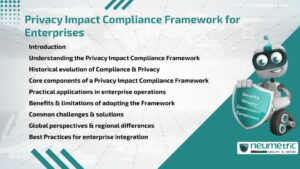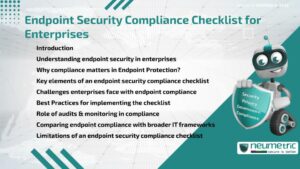Table of Contents
ToggleIntroduction
An endpoint security compliance checklist is a structured tool that enterprises use to ensure all devices connected to their networks follow security standards & regulations. With the rising number of laptops, mobile phones, tablets & Internet of Things devices in workplaces, endpoints have become prime targets for Cyber Threats. By applying a compliance checklist, Organisations can reduce Risks of breaches, improve resilience & demonstrate adherence to legal & industry requirements. This article explores what an endpoint security compliance checklist entails, why it matters for enterprises & how businesses can implement it effectively.
Understanding endpoint security in enterprises
Endpoint security focuses on safeguarding all access points where users & devices connect to an enterprise system. These endpoints include desktops, remote laptops & mobile devices. If not secured, they can serve as entry doors for attackers. Unlike centralized network protection, endpoint security requires a distributed approach, where each device complies with strict Security Measures to prevent unauthorized access.
Why compliance matters in Endpoint Protection?
Compliance ensures that Security Measures align with regulatory expectations & Industry Standards. Frameworks such as ISO 27001, NIST & GDPR emphasize the importance of Endpoint Protection in data handling. For enterprises, compliance is not only about avoiding fines but also about maintaining trust with clients, partners & Stakeholders. A well-applied endpoint security compliance checklist acts as a safeguard against costly legal & reputational damage.
Key elements of an endpoint security compliance checklist
An effective checklist usually includes:
- Strong authentication mechanisms like multi-factor authentication.
- Regular software updates & Patch Management.
- Encryption for Sensitive Data at rest & in transit.
- Device Access Control & privilege management.
- Malware detection & prevention solutions.
- Backup & Disaster Recovery planning.
- Employee Training on secure device usage.
Each element ensures that Vulnerabilities are minimized & that security is integrated into everyday enterprise operations.
Challenges enterprises face with endpoint compliance
Implementing an endpoint security compliance checklist comes with difficulties. Large enterprises often deal with thousands of devices across multiple geographies, making it challenging to standardize protection. Employees working remotely may bypass Policies due to convenience. Moreover, legacy systems may not support modern Security Controls, increasing exposure to Risks. Balancing productivity with compliance remains a constant struggle.
Best Practices for implementing the checklist
Enterprises can achieve better results by:
- Automating endpoint monitoring & Patch Management.
- Establishing clear Policies for remote & mobile work.
- Conducting regular awareness training for Employees.
- Integrating endpoint compliance with identity management solutions
- Performing routine internal audits to measure adherence
These practices help transform compliance from a one-time exercise into a continuous process.
Role of audits & monitoring in compliance
Audits play a central role in validating that enterprises follow their endpoint security compliance checklist. regular Audits highlight gaps, while ongoing monitoring ensures Corrective Action is immediate. By combining automated Monitoring Tools with manual assessments, enterprises can keep endpoint controls relevant in dynamic business environments.
Comparing endpoint compliance with broader IT frameworks
While endpoint compliance focuses specifically on device-level security, it connects closely with larger IT Governance structures. For example, frameworks like COBIT & HIPAA also reference Endpoint Protection as part of their controls. Comparing endpoint compliance with these frameworks helps enterprises understand how device-level security integrates into enterprise-wide Governance.
Limitations of an endpoint security compliance checklist
While valuable, a checklist is not a silver bullet. It may create a false sense of security if Organisations rely on ticking boxes rather than addressing deeper Vulnerabilities. Compliance does not guarantee absolute protection against sophisticated attacks. Moreover, rapidly evolving Threats may outpace static checklist items, requiring enterprises to constantly update their approach.
Conclusion
An endpoint security compliance checklist is essential for enterprises to safeguard devices, align with standards & reduce Vulnerabilities. By recognizing its strengths & limitations, Organisations can integrate it into a broader security strategy that protects both data & reputation.
Takeaways
- An endpoint security compliance checklist helps standardize device protection across enterprises.
- Compliance supports both regulatory requirements & business trust.
- Key elements include authentication, encryption, patching & training.
- Challenges include scale, remote work & outdated systems.
- Continuous auditing & monitoring strengthen checklist effectiveness.
FAQ
What is an endpoint security compliance checklist?
It is a structured set of security requirements designed to protect enterprise devices from Cyber Threats while ensuring compliance with regulations.
Why is endpoint compliance important for enterprises?
It ensures that device security aligns with Industry Standards, protects Sensitive Data & reduces Risks of penalties & breaches.
What should be included in an endpoint security compliance checklist?
Key items include authentication, encryption, software patching, malware protection & Employee Training.
How often should enterprises update their endpoint compliance checklist?
It should be reviewed regularly, ideally every six (6) to twelve (12) months, to address new Threats & regulatory changes.
Does compliance guarantee complete Endpoint Protection?
No, compliance reduces Risks but does not eliminate all Threats. Continuous Monitoring & adaptation are still required.
How do audits support endpoint compliance?
Audits identify weaknesses, verify checklist adherence & help Organisations improve endpoint Security Measures.
Are small enterprises required to use the same checklist as large Organisations?
While the principles are the same, smaller enterprises can scale down the checklist to match their resources & device environments.
Need help for Security, Privacy, Governance & VAPT?
Neumetric provides organisations the necessary help to achieve their Cybersecurity, Compliance, Governance, Privacy, Certifications & Pentesting needs.
Organisations & Businesses, specifically those which provide SaaS & AI Solutions in the Fintech, BFSI & other regulated sectors, usually need a Cybersecurity Partner for meeting & maintaining the ongoing Security & Privacy needs & requirements of their Enterprise Clients & Privacy conscious Customers.
SOC 2, ISO 27001, ISO 42001, NIST, HIPAA, HECVAT, EU GDPR are some of the Frameworks that are served by Fusion – a SaaS, multimodular, multitenant, centralised, automated, Cybersecurity & Compliance Management system.
Neumetric also provides Expert Services for technical security which covers VAPT for Web Applications, APIs, iOS & Android Mobile Apps, Security Testing for AWS & other Cloud Environments & Cloud Infrastructure & other similar scopes.
Reach out to us by Email or filling out the Contact Form…





